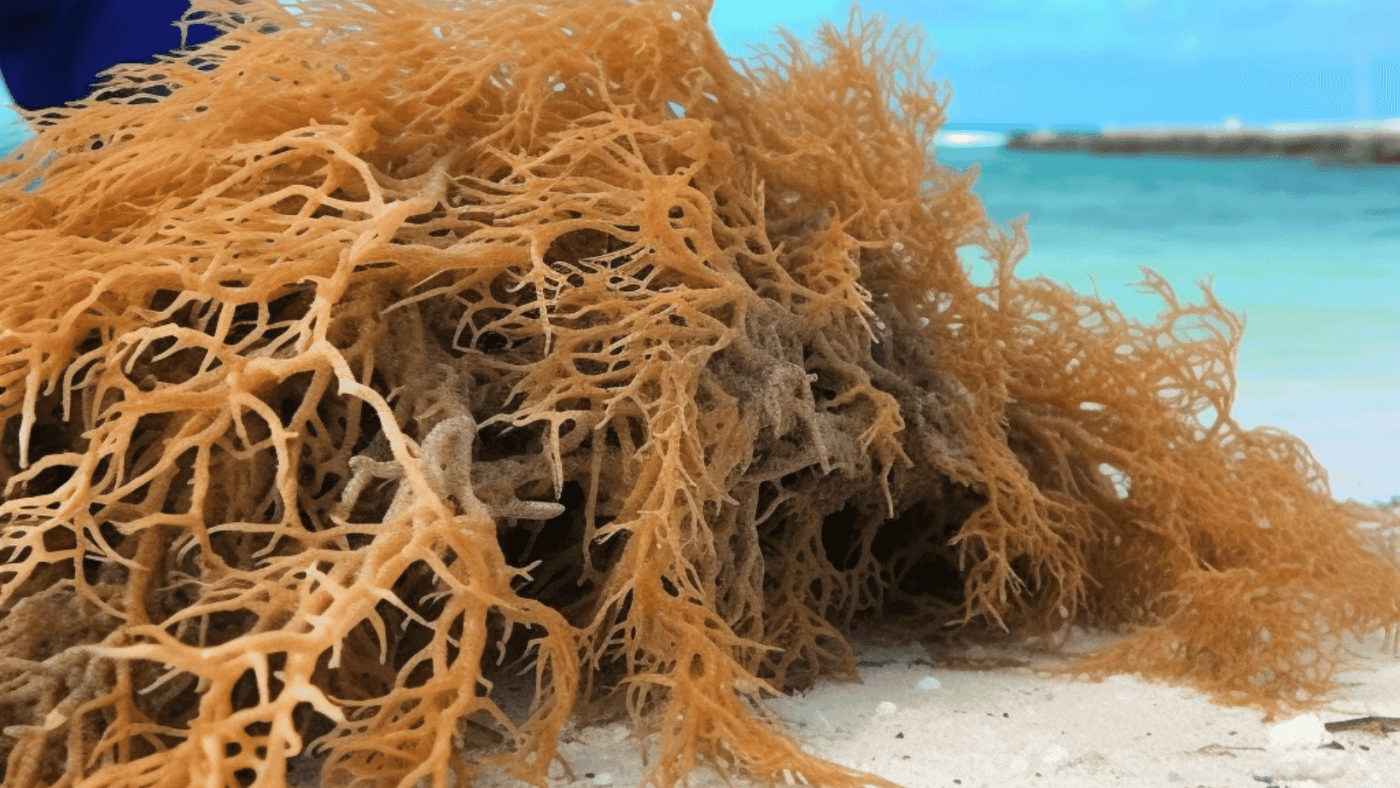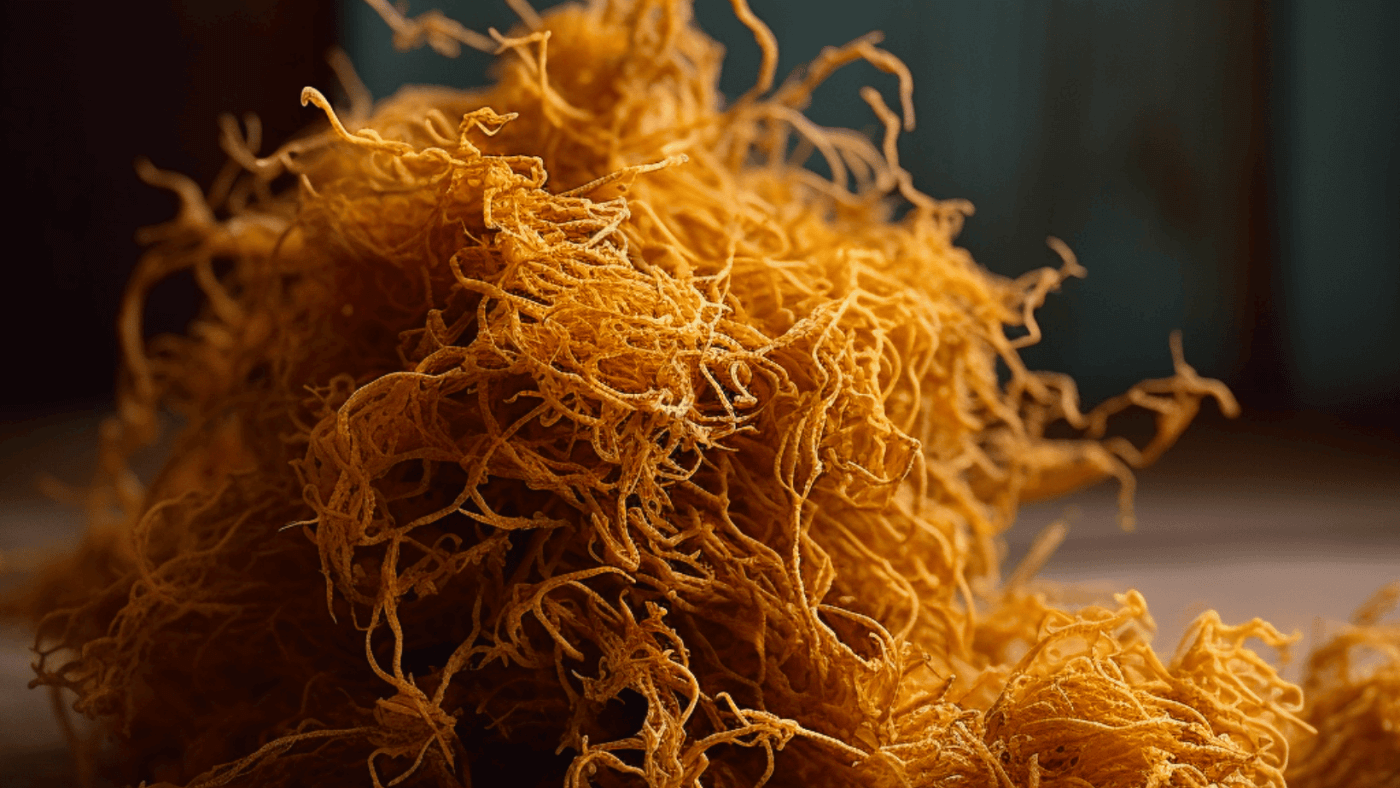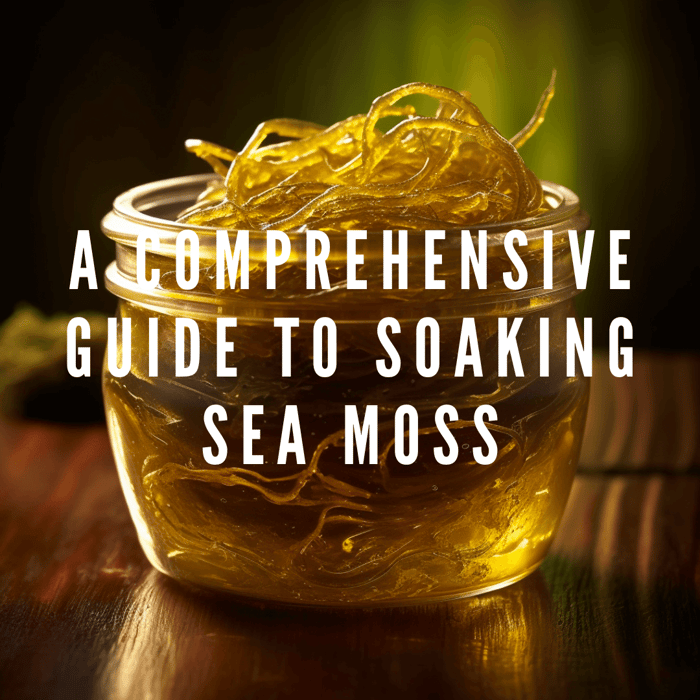Table of Contents
Importance of Preparing Sea Moss Properly
Sea moss, a nutrient-rich superfood, requires careful preparation to maximize its health benefits. This process involves three key considerations: safety, taste and texture, and nutrient preservation.
Safety considerations
Proper preparation of sea moss ensures that it is free from harmful substances. This includes removing any sea debris and thoroughly cleaning the sea moss before soaking.
Taste and texture considerations
Soaking sea moss not only cleans it but also softens its texture, making it more palatable. The soaking process also helps to remove any lingering ocean taste, allowing the sea moss to blend seamlessly into your recipes.
Nutrient preservation considerations
Sea moss is packed with essential minerals and vitamins. To preserve these nutrients, it's crucial to avoid soaking in hot water, which can degrade its nutritional profile. Instead, use cold, preferably alkaline water for soaking.

How to Source Your Sea Moss Sustainably and Ethically
With the growing popularity of sea moss, it's important to source it sustainably and ethically. This involves considering factors such as organic vs. non-organic sea moss, fresh vs. dried sea moss, and ethical sourcing guidelines.
Tips: Organic vs. non-organic sea moss
Organic sea moss is grown without the use of harmful chemicals, making it a healthier choice. Non-organic sea moss, on the other hand, may contain traces of pesticides and other chemicals. Always look for certified organic labels when purchasing sea moss.
Fresh vs. dried sea moss
Both fresh and dried sea moss have their advantages. Fresh sea moss is ready to use, while dried sea moss has a longer shelf life. However, dried sea moss requires soaking before use to rehydrate and clean it.
Guidelines on ethical and sustainable sourcing
Ensure your sea moss is harvested in a way that doesn't harm the environment or exploit workers. Look for suppliers who are transparent about their harvesting practices. Check out our collection of ethically sourced sea moss here.

Cleaning Your Sea Moss Properly
Before soaking your sea moss, it's crucial to clean it thoroughly. This involves identifying and removing naturally occurring debris, and ensuring cleanliness without damaging the sea moss.
Why it's important to clean sea moss
Sea moss naturally contains sea salt, sand, and other ocean debris. Cleaning removes these impurities, ensuring you're consuming pure, clean sea moss.
Identifying naturally occurring debris in sea moss
Look for small particles of sand, shells, or seaweed in your sea moss. These are naturally occurring and can be easily removed during the cleaning process.
Steps for cleaning sea moss thoroughly
First, rinse your sea moss under cold running water. Use your fingers to gently rub the sea moss, removing any visible debris. Repeat this process until the water runs clear.
Tips for ensuring cleanliness without damaging sea moss
Be gentle when cleaning sea moss to avoid tearing it. Also, avoid using hot water as it can degrade the sea moss's nutritional profile.

The Role of Alkaline Water in Soaking Sea Moss
Alkaline water plays a crucial role in the soaking process of sea moss. It not only helps to clean the sea moss but also enhances its nutritional profile.
Explanation of what alkaline water is
Alkaline water has a higher pH level than regular drinking water. This means it can neutralize acid in your body, which can lead to improved health benefits.
Benefits of using alkaline water in the soaking process
Soaking sea moss in alkaline water helps to remove any lingering ocean taste, making it more palatable. It also helps to preserve the sea moss's nutrients, enhancing its health benefits.
How to make or buy alkaline water
You can buy alkaline water from most grocery stores, or you can make it at home by adding baking soda to regular water. However, be sure to consult with a healthcare professional before consuming homemade alkaline water regularly.
Steps to soak sea moss in alkaline water
First, place your cleaned sea moss in a large bowl. Then, pour enough alkaline water to fully submerge the sea moss. Let it soak for 12-24 hours, depending on the thickness of the sea moss.

The Soaking Process
Soaking sea moss is an essential step in its preparation. This process involves understanding the soaking time, observing changes in the sea moss post-soaking, and avoiding common mistakes.
Detailed instructions for soaking sea moss
After cleaning, place your sea moss in a large bowl and cover it with alkaline water. Ensure all parts of the sea moss are submerged. Cover the bowl and let it soak for 12-24 hours at room temperature.
Explanation of soaking time
The soaking time for sea moss can vary depending on its thickness and the temperature of your room. Generally, thicker sea moss requires a longer soaking time. A good rule of thumb is to soak until it has doubled in size and become gelatinous in texture.
Description of changes in sea moss post soaking
After soaking, sea moss should be soft and expanded in size. Its color may also become lighter. These changes indicate that the sea moss is ready to be used in your recipes or stored for later use.
Common mistakes to avoid while soaking
Avoid soaking sea moss in hot water as it can degrade its nutritional profile. Also, ensure the sea moss is fully submerged in water to allow for even soaking. Check out our guide for more tips on soaking sea moss.

Using Limes as a Natural Preservative
Limes can be used as a natural preservative during the soaking process of sea moss. They offer several benefits, including antibacterial properties and extending the shelf-life of sea moss.
Benefits of lime as a natural preservative
Lime juice contains citric acid, which acts as a natural preservative. It helps to prevent the growth of bacteria and extends the shelf-life of the sea moss.
Anti-bacterial properties of lime
Lime has potent antibacterial properties that can help to keep your sea moss fresh for longer. It's a natural and safe way to preserve your sea moss without the use of artificial preservatives.
How lime extends the shelf-life of sea moss
The citric acid in lime slows down the oxidation process, preventing the sea moss from spoiling quickly. This allows you to store your sea moss for longer periods.
Steps to use limes during the soaking process
After soaking your sea moss, rinse it one last time and squeeze the juice of one lime over it. Mix well to ensure the lime juice is evenly distributed. This step is optional but recommended for longer storage.
Comparison of other natural preservatives with lime
Other natural preservatives like lemon and grapefruit can also be used, but lime is often preferred due to its higher citric acid content. However, the choice of preservative can also depend on personal taste preferences.

Storing Your Soaked Sea Moss
Proper storage of soaked sea moss is crucial to maintain its freshness and nutritional value. This involves understanding the different storage options and identifying when your sea moss has gone bad.
Tips on storing soaked sea moss
Store your soaked sea moss in an airtight container in the refrigerator. It can last up to 3 weeks when stored properly. For longer storage, you can freeze the sea moss where it can last up to 1 year.
Short-term vs. long-term storage options
For short-term storage, refrigeration is the best option. If you plan to use the sea moss within a few weeks, keep it in the fridge. For long-term storage, freezing the sea moss is recommended. Always store in an airtight container to prevent exposure to air and moisture.
Identifying when your sea moss has gone bad
If your sea moss develops a foul smell, changes color, or shows signs of mold, it has likely gone bad and should be discarded. Always check your sea moss before use to ensure it's still fresh.

Utilizing Soaked Sea Moss
Soaked sea moss can be used in a variety of ways, from dietary to skincare applications. Here are some simple recipes and uses for your soaked sea moss.
Simple recipes for incorporating soaked sea moss in your diet
Soaked sea moss can be blended into a gel and used in smoothies, soups, and sauces. It can also be added to baked goods for a nutritional boost. Check out our collection of sea moss recipes here.
Other uses of soaked sea moss in skincare, etc.
Sea moss gel can also be used as a natural skin moisturizer, hair mask, or soothing agent for sunburns. Its high mineral content makes it a great addition to your skincare routine.

FAQs about Soaking Sea Moss
What is the best way to soak sea moss?
The best way to soak sea moss is in cold, preferably alkaline water for 12-24 hours. Ensure all parts of the sea moss are submerged in the water.
How long can you soak sea moss?
You can soak sea moss for 12-24 hours, depending on its thickness. Thicker sea moss may require a longer soaking time.
Do you soak sea moss in hot or cold water?
You should soak sea moss in cold water. Hot water can degrade the nutritional profile of the sea moss.
Do you have to let sea moss soak?
Yes, you need to let sea moss soak. Soaking helps to clean the sea moss, remove any lingering ocean taste, and soften its texture.
Do you rinse sea moss after soaking?
Yes, you should rinse sea moss after soaking. This helps to remove any remaining impurities and excess salt.
What is the longest you can soak sea moss for?
The longest you can soak sea moss is typically 24-48 hours. Beyond this, it might start to lose its nutritional properties.
Does soaked sea moss go in the fridge?
Yes, soaked sea moss should be stored in the fridge. It can last up to 3 weeks when stored properly in an airtight container.
What should you soak sea moss in?
You should soak sea moss in filtered, spring, or alkaline water. Alkaline water is often preferred as it can enhance the nutritional profile of the sea moss.
 is here! Shop now, pay later in 4 easy installments
is here! Shop now, pay later in 4 easy installments



